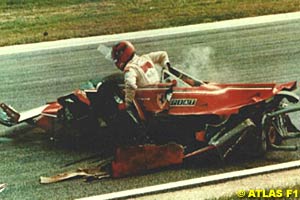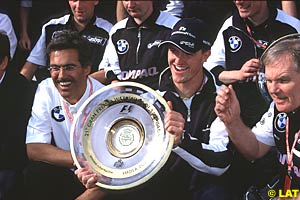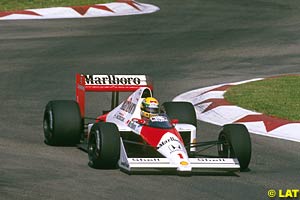
Atlas F1 Magazine Writer
How many times did Imola hold the opening race of the 'European season'? Which driver has the best qualifying record on that track? And how many times did the winner become the Champion of that year? Marcel Schot brings the answers and more anecdotes on the San Marino GP
What is remarkable about this list, is that since 1986, the only time the first race in Europe was the Grand Prix of the country the circuit is located in, was the 1992 Spanish Grand Prix.
This habit of staging two races in one country first took shape in 1957, when both the Italian Grand Prix and the Pescara Grand Prix were held in Italy. For a long time it appeared like it was a one time event, even though quite a few British Grands Prix were dubbed 'European Grand Prix'. The first permanent 'double bill' Grand Prix was the USA-West Grand Prix at Long Beach, running from 1976 until 1983. 1982 was the season with the most second Grands Prix:
The list of drivers who won two races in one country in a single season is very limited:
So Michael Schumacher isn't the first to win two races in Italy in a single season, but the fact that he did it in a Ferrari gave him a status among the tifosi only equaled by the legendary Gilles Villeneuve.
In the career of Gilles Villeneuve, there were two events at Imola that stand out. First, his crash in 1980, and then his 'stolen' victory in 1982 that some claim ultimately lead to his death at Zolder in the next Grand Prix.
However, Villeneuve was fully conscious and very aware of the rest of the field blasting by. Frantically, the Ferrari driver was waving his hands and once his eyesight had returned and the other drivers had all passed, the French Canadian climbed out of the wreckage and walked off to have himself checked by the medical staff. Obviously he was sore all over and had a massive headache, but the thing that probably hurt him the most, was that he wasn't allowed to fly his helicopter for 24 hours.
When speaking of Villeneuve, Schumacher and Imola, you almost automatically wonder how Ferrari drivers do in their second home Grand Prix. In terms of wins, both Williams (8) and McLaren (5) scored more than Ferrari's 4, but the Maranello team's 17 podium finishes are unrivaled.
When we look at the winners in Imola, it is interesting to note that the winner has rarely won the Championship of that season in recent years. The last two World Champions that won Imola in their Championship year were Michael Schumacher in 2000 and Damon Hill in 1996.
Historically, the up and coming boys of Renault are candidates for success. With seven wins at Imola, Renault engines are by far the strongest. However, Jarno Trulli has been much more of a force in his home country than Jenson Button. Trulli finished fifth last year, while Button had to settle for 12th after starting a disastrous 21st.
Outside the cars, the central subjects of discussion at Imola are babies. In 1999, both Giancarlo Fisichella and Michael Schumacher became the proud fathers in the forthnight leading up to the San Marino Grand Prix. A year later, Heinz-Harald Frentzen was almost happy he retired early; the German went home quickly and became a father the next day. Last year, Imola saw the return to the paddock of Erja Hakkinen for the first time after the birth of son Hugo, while Ralf Schumacher announced he and his Cora were expecting a baby.
With the recent discussions on whether Michael Schumacher can or cannot break Ayrton Senna's record of 65 Pole Positions, Imola will be an interesting qualifying session. Not that Schumacher is anywhere near 65 poles, but Imola is somewhat of a proving ground. It was here that Ayrton Senna was the master of the flying lap. No less than eight times was the Brazilian crowned the Imola king of Saturday.
In the race, Michael Schumacher can achieve yet another landmark. If the German leads for twenty or more laps, he'll have driven over 15,000 kms in the lead. He already leads the table of most kms driven in the lead, so it would be nothing more than a statistical milestone in a career of bigger records.
Imola wasn't always the opening race of the 'European season'. Ever since Imola hosted its first Championship race in 1980, the venue has been the first European round on the calendar 14 times. Other venues to open the European streak of races are:
Paul Ricard 1983
Zolder 1980,1984
Estoril 1985
Jerez 1986
Catalunya 1992
Donington 1993
Imola 1981-82,1987-91,1994-95,1997,1998-2002
Nurburgring 1996
 The crash in the 1980 race - the only Italian Grand Prix at Imola - was one of the heaviest in Formula One history in which nobody was hurt. Coming out of Tosa, Gilles's right rear tyre exploded at a speed of 180mph and he flew right into the wall without losing speed. The car was literally torn into pieces and one of the loose wheels hit Villeneuve in the helmet, and for thirty seconds he lost his eyesight.
The crash in the 1980 race - the only Italian Grand Prix at Imola - was one of the heaviest in Formula One history in which nobody was hurt. Coming out of Tosa, Gilles's right rear tyre exploded at a speed of 180mph and he flew right into the wall without losing speed. The car was literally torn into pieces and one of the loose wheels hit Villeneuve in the helmet, and for thirty seconds he lost his eyesight.
 Last season, Ralf Schumacher grabbed his maiden victory at Imola, making him the second driver to score his maiden victory on Circuit Enzo e Dino Ferrari. The first one was fellow German Heinz-Harald Frentzen in 1997, also in a Williams. Surprisingly, the most maiden victories were scored in Monaco. No less than eight drivers took their debut victory in the principality, but more on that next month, when the F1 circus arrives there.
Last season, Ralf Schumacher grabbed his maiden victory at Imola, making him the second driver to score his maiden victory on Circuit Enzo e Dino Ferrari. The first one was fellow German Heinz-Harald Frentzen in 1997, also in a Williams. Surprisingly, the most maiden victories were scored in Monaco. No less than eight drivers took their debut victory in the principality, but more on that next month, when the F1 circus arrives there.
 So far, Michael Schumacher shares second place with Rene Arnoux, Mika Hakkinen and David Coulthard with a mere two pole positions each. One of the reasons that Senna was as dominant in Imola as he was, lies in the difficulty of the circuit. With its many different types of corners, it demands more concentration and ability to determine the perfect balance in the setup of the car than any other circuit except Monaco.
So far, Michael Schumacher shares second place with Rene Arnoux, Mika Hakkinen and David Coulthard with a mere two pole positions each. One of the reasons that Senna was as dominant in Imola as he was, lies in the difficulty of the circuit. With its many different types of corners, it demands more concentration and ability to determine the perfect balance in the setup of the car than any other circuit except Monaco.
Past Performance by Current Drivers
| 1996 | 1997 | 1998 | 1999 | 2000 | 2001 | Average Qualifying Position |
|||||||
| Qual | Race | Qual | Race | Qual | Race | Qual | Race | Qual | Race | Qual | Race | ||
| M.Schumacher | 1 | 2 | 3 | 2 | 3 | 2 | 3 | 1 | 2 | 1 | 4 | M | 2.666 |
| Barrichello | 9 | 5 | 13 | M | 17 | R | 6 | 3 | 4 | 4 | 6 | 3 | 9.166 |
| Coulthard | 4 | M | 10 | M | 1 | 1 | 2 | 2 | 3 | 3 | 1 | 2 | 3.500 |
| Raikkonen | - | - | - | - | - | - | - | - | - | - | 10 | M | 10.000 |
| R.Schumacher | - | - | 5 | M | 9 | 7 | 9 | 4 | 5 | M | 3 | 1 | 6.200 |
| Montoya | - | - | - | - | - | - | - | - | - | 7 | M | 7.000 | |
| Heidfeld | - | - | - | - | - | - | - | - | 22 | M | 12 | 7 | 17.000 |
| Massa | - | - | - | - | - | - | - | - | - | - | - | - | - |
| Fisichella | 19 | M | 6 | 4 | 10 | R | 16 | 5 | 19 | 11 | 19 | M | 14.833 |
| Sato | - | - | - | - | - | - | - | - | - | - | - | - | - |
| Villeneuve | 3 | 11 | 1 | M | 6 | 4 | 5 | M | 9 | 5 | 11 | M | 5.833 |
| Panis | 13 | M | 4 | 8 | 13 | 11 | 11 | M | - | - | 8 | 8 | 9.800 |
| Trulli | - | - | 20 | M | 16 | M | 14 | R | 8 | 15 | 5 | 5 | 12.600 |
| Button | - | - | - | - | - | - | - | - | 18 | M | 21 | 12 | 19.500 |
| Frentzen | 10 | M | 2 | 1 | 8 | 5 | 7 | R | 6 | M | 9 | 6 | 7.000 |
| Bernoldi | - | - | - | - | - | - | - | - | - | - | 16 | 10 | 16.000 |
| Irvine | 6 | 4 | 9 | 3 | 4 | 3 | 4 | M | 7 | 7 | 13 | M | 7.166 |
| de la Rosa | - | - | - | - | - | - | 18 | R | 13 | R | - | - | 15.500 |
| Yoong | - | - | - | - | - | - | - | - | - | - | - | - | - |
| Webber | - | - | - | - | - | - | - | - | - | - | - | - | - |
| Salo | 8 | M | 19 | 9 | 14 | 9 | 19 | 7 | 12 | 6 | - | - | 14.600 |
| McNish | - | - | - | - | - | - | - | - | - | - | - | - | - |
Please Contact Us for permission to republish this or any other material from Atlas F1.
|
Volume 8, Issue 15
Atlas F1 Exclusive
Jo Ramirez: a Racing Man
Articles
The Hotheaded and the New Iceman
Selling Sato
San Marino GP Preview
San Marino GP Preview
Local History: San Marino GP
Facts, Stats & Memoirs
Columns
The San Marino GP Quiz
Rear View Mirror
Bookworm Critique
Elsewhere in Racing
The Grapevine
> Homepage |